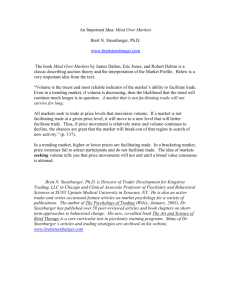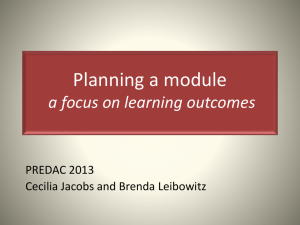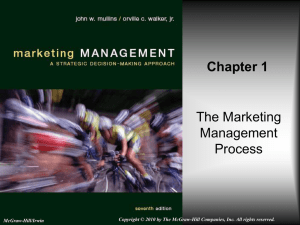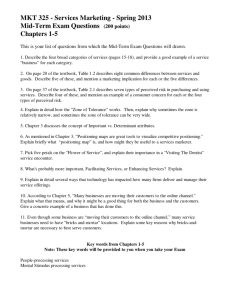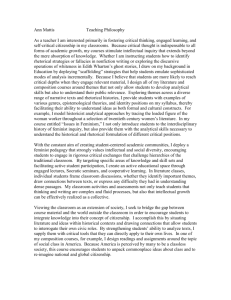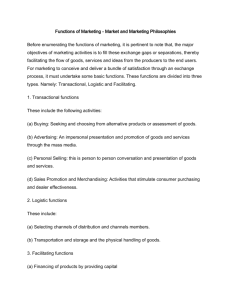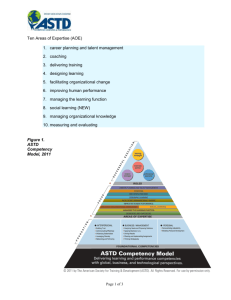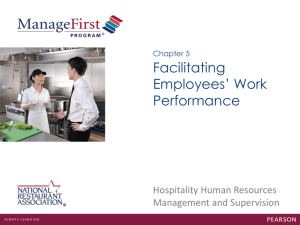Management of Innovation Some Important Issues
advertisement
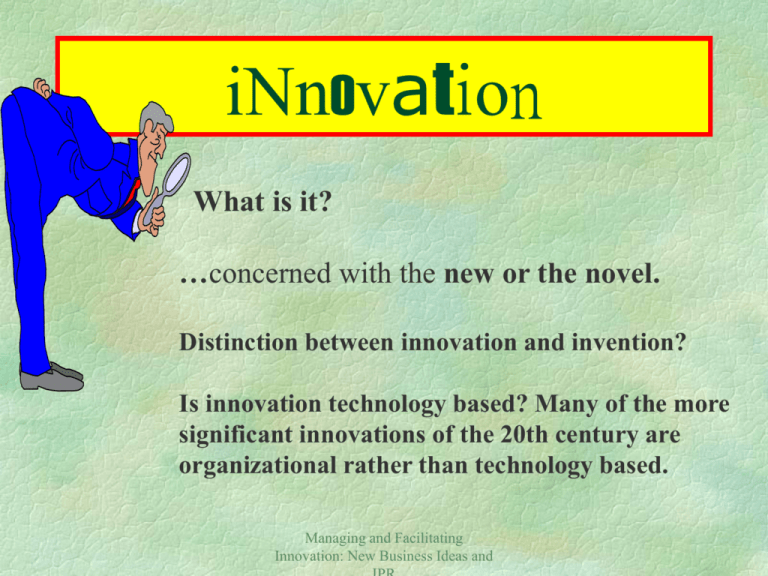
iNnovation What is it? …concerned with the new or the novel. Distinction between innovation and invention? Is innovation technology based? Many of the more significant innovations of the 20th century are organizational rather than technology based. Managing and Facilitating Innovation: New Business Ideas and Some useful definitions Fritz Machlup wrote in 1962, “Ought we perhaps to avoid the term innovation’ since it is so promiscuosly used for a variety of meanings”. Building on Schumpeter’s useful definition between invention and innovation “Invention implies bringing something new into being; innovation implies bringing something new into use”. Innovation has been defined as the successful introduction into an applied situation of means or ends that are new to that situation. (Mohr, 1969, quoted in Cummings and O’Connell, 1978, p.34) Managing and Facilitating Innovation: New Business Ideas and An innovation may therefore be a thing! Whether artefact, product or process or indeed service, system or infrastructure The innovation process should also be remembered. Need to differentiate between types of innovation and stages of adoption to facilitate developing useful theories of organizational development. Distinguish between: Product and process innovations Technical and organizational innovations Radical and incremental innovations Managing and Facilitating Innovation: New Business Ideas and Management of Innovation Some Important Issues Within an organisation Fundamental tension between stability and creativity Conflict between top and lower tiers? Between strategy making and local autonomy? Managing and Facilitating Innovation: New Business Ideas and Main sources and strategies for innovation “Innovation is work rather than genius”,…and very much a matter of discipline (Peter F Drucker, 1985) Concept of uncertainty matrix offers characteristics which reduce the risks of innovation (Alan W Pearson, ). Knowledge creation and innovation: Four standpoints Managing and Facilitating Innovation: New Business Ideas and Strategic Innovation Peter F Druker What all successful entrepreneurs have is not a certain kind of personality but a commitment to the systematic practice of innovation. All sizes of businesses engage in highly successful entrepreneurship. Hence it is an activity!! At the heart of that activity is innovation. Sources of innovation: *Within a company: Unexpected occurences Incongruities Process needs Industry and market changes *Outside a company: Demographic changes Changes in perception New knowledge Managing and Facilitating Innovation: New Business Ideas and Managing Innovation: an uncertainty reduction process Alan W. Pearson Innovation means change. Such changes can be incremental or radical, evolutionary or revolutionary, enabling or disruptive. They can have different effects upon producers and users. “intuitive..tumultous process…Individual discoveries tend to be highly individualistic andserendipitous, advances chaotic and interactive, and specific outcomes unpredictable and chancy until the very last moment” (Quinn, 1986). Technological innovation is therefore a messy process! Managing and Facilitating Innovation: New Business Ideas and Pearson’s Uncertainty Map Applications engineering Uncertainty about output ENDS Exploratory research Technical market Development combination engineering Uncertainty about process MEANS Managing and Facilitating Innovation: New Business Ideas and Knowledge Creation From four standpoints: 1. Knowledge creation in the process of design, emphasizing the role of reflective practitioner 2. Nonaka’s framework for analysing knowledge creation as the interplay of tacit and explicit knowledge. 3. Knowledge creation through experimenting and prototyping. 4. Learning and innovation. Managing and Facilitating Innovation: New Business Ideas and Knowledge Creation Continuous innovation Competitive advantage Knowledge creation as the basis of competitive advantage (Nonaka and Takeuchi, 1995) Managing and Facilitating Innovation: New Business Ideas and Intellectual Capital * In 1969 J.K.Galbraith used the term ‘intellectual capital’, defining it as more than ‘intellect as pure intellect’ but rather as including some type of intellectual action (Bontis, 1996). * Thomas A.Stewart, editor of Fortune magazine, whose first article, * ‘Brainpower’ (1991), acted as a catalyst for incorporating intellectual capital into managerial thought and activities. Since than it has undergone many transformations, and is now definable by those intangible assets that do not show up on companies’ financial statements, and specifically, those which can be codified, and valued and managed by a company. Popular business writers such as Stewart(1991) define it as the combination of patents, processes, management skills, technologies, information about customers and suppliers, and experienec. Economists define it as Tobin’s-q (Tobin, 1969), a broad proportional measure of market value to book value. Managing and Facilitating Innovation: New Business Ideas and Intellectual Property Rights IPR is qualitatively different from most others within the intellectual capital area, notably because these rights are legally enforceable. Exploitation of IPR Defense by companies of their knowledge against those who seek to appropriate it. Managing and Facilitating Innovation: New Business Ideas and
